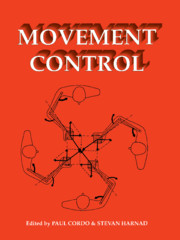Book contents
- Frontmatter
- Contents
- Preface
- 1 Does the nervous system use equilibrium-point control to guide single and multiple joint movements?
- 2 Does the nervous system depend on kinesthetic information to control natural limb movements?
- 3 Can sense be made of spinal interneuron circuits?
- 4 Implications of neural networks for how we think about brain function
- 5 Do cortical and basal ganglionic motor areas use “motor programs” to control movement?
- 6 Functional heterogeneity with structural homogeneity: How does the cerebellum operate?
- 7 Are movement parameters recognizably coded in the activity of single neurons?
- 8 The representation of egocentric space in the posterior parietal cortex
- Open Peer Commentary and Authors' Responses
- References
- Index
3 - Can sense be made of spinal interneuron circuits?
Published online by Cambridge University Press: 11 December 2009
- Frontmatter
- Contents
- Preface
- 1 Does the nervous system use equilibrium-point control to guide single and multiple joint movements?
- 2 Does the nervous system depend on kinesthetic information to control natural limb movements?
- 3 Can sense be made of spinal interneuron circuits?
- 4 Implications of neural networks for how we think about brain function
- 5 Do cortical and basal ganglionic motor areas use “motor programs” to control movement?
- 6 Functional heterogeneity with structural homogeneity: How does the cerebellum operate?
- 7 Are movement parameters recognizably coded in the activity of single neurons?
- 8 The representation of egocentric space in the posterior parietal cortex
- Open Peer Commentary and Authors' Responses
- References
- Index
Summary
Abstract: It is increasingly clear that spinal reflex systems cannot be described in terms of simple and constant reflex actions. The extensive convergence of segmental and descending systems onto spinal interneurons suggests that spinal interneurons are not relay systems but rather form a crucial component in determining which muscles are activated during voluntary and reflex movements. The notion that descending systems simply modulate the gain of spinal interneuronal pathways has been tempered by the observation that spinal interneurons gate and distribute descending control to specific motoneurons. Spinal reflex systems are complex but current approaches will continue to provide insight into motor systems. During movement, several neural mechanisms act to reduce the functional complexity of motor systems by inhibiting some of the parallel reflex pathways available to segmental afferents and descending systems. The flexion reflex system is discussed as an example of the flexibility of spinal interneuron systems and as a useful conceptual construct. Examples are provided of the kinds of experiments that can be developed using current approaches to spinal interneuronal systems.
- Type
- Chapter
- Information
- Movement Control , pp. 31 - 41Publisher: Cambridge University PressPrint publication year: 1994
- 3
- Cited by



